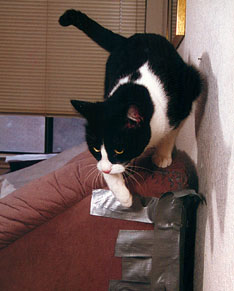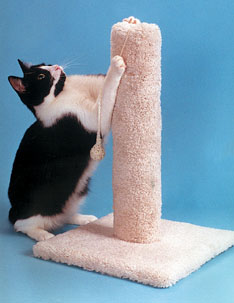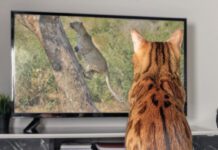
234
If your cat is doing a number on your furnishings, dont throw in the towel. You and your cat can live in an environment that is aesthetically pleasing to you and safe and comfortable for your cat. All it takes is a little planning – and looking at your home from a cats eye view.
Furniture Fracas
When Fluffy attacks your sofa, she is exercising her right to define her space. Clawing is one way cats mark their territory, and the session is as close to a manicure she may ever get. Clawing removes the nail sheaths new nails grow. Placing clear LuciteTM covers or Sticky PawsTM on your sofa ends or simply setting small scratching posts at strategic locations may deter her from using the upholstery as a nail file.
A scratching post or even a log may work, says James Richards, DVM, director of the Cornell Feline Health Center. Its easiest to train your cat to use the post when shes a kitten, but if shes past the juvenile stage, you can still redirect her other things besides your furniture. Some cats prefer posts placed vertically, other like them to be horizontal. If she forgets to use the post, it helps to keep her nails trimmed, says Dr. Richards.
Providing your cat with her own furniture may help keep her off of yours. Multi-level trees with a variety of surfaces such as carpet, wood and sisal provide scratching alternatives and amusement. It can be helpful for some cats to spend their time on their own furniture, says Dr. Richards. If you dont like the look of most cat furniture, you have other options such as wall-mounted climbing sconces and shelves.
If you are planning to buy new furniture, the best type may depend on your cat. Cats reserve the right to be individuals, says Dr. Richards.
As a general rule, upholstered furniture attracts some cats like a magnet. If you have upholstered furniture that you want to protect, opt for washable slip covers in fabrics less likely to appeal to your cat, such as cotton, velour, chintz or Ultrasuede. If slip covers are out of the question, cover your upholstered pieces with attractive throws or even small rugs that you and your cat will love to sit on and can be removed to clean. Purchase pet mats to place on your furniture to keep your cat warm and your chairs clean.
When it comes time to replace the furniture, you should opt for chairs or sofas made of wood, rattan or other high-tech materials. A butterfly chair with a removable cover is comfortable yet stylish and easy to clean. Futons whose covers can be replaced is another alternative. If your cat does decide that wood or rattan is the scratch surface of choice, you can make it less appealing by spraying FeliwayTM on the surface. FeliwayTM contains facial pheromones, says Dr. Richards, and may change the cats desire from one of scratching to simply rubbing her cheek.
Safety is a primary consideration, and some furniture can be outright dangerous.
Be careful how the furniture is constructed, says Dr. Richards. Stay away from recliners. If a cat crawls into it, she can be crushed in the mechanical parts when the recliner is opened or closed.
Rocking chairs can damage a cats tail or paw if accidentally rocked on. If youd like the comfort of a recliner or rocker, look into a swivel rocker with a foot rest as a safer alternative.

234
In the book Animal House Style, author Julia Szabo recommends crawling around your house at your pets eye level to see what hidden dangers might injure an unsuspecting cat. Coffee tables with sharp edges, cleaning products out in the open, spaces that your cat might slip into and become trapped are all environmental hazards that can be avoided. Look for anything on your furniture that might poke, squeeze, trap, or otherwise harm your cat.
No matter what kind of furniture you select, your cat is bound to deposit hair on it. Mini vacs, dampened rubber gloves, sticky rollers, and even masking tape are ways to easily keep from being overwhelmed by loose cat hair.
Low-Maintenance Floors
Most animal care facilities have bare floors of a material such as concrete, wood or vinyl that are easy to clean. Cats are famous for upchucking hairballs or eating too fast and regurgitating the food, so an uncarpeted floor may be an advantage. Bare floors can be cleaned with a dust mop or SwifferTM. If you dont like the look of bare floors, they can be stained or painted to make them more interesting.
The downside to bare floors is that cat hair wafts through the air. Carpet will keep the hair down, but it is more difficult to clean, and you may find yourself doing spot cleaning more often than youd like. Its a trade-off, says Dr. Richards.
Carpet with a tighter weave such as an Oriental is easier to clean as the stain doesnt soak through. Some carpet comes with a special backing to prevent pet accidents from soaking through to the padding. Carpet is also warmer for both you and your cat.
Objects dArt
If you have interesting objects sitting around and dont want to see them go flying as your cat leaps over them, try using some E-Z TakTM on the bottoms to hold them in place. This product is available in craft stores. Try a bit of it on an area of the furniture that is not visible to make certain it does not discolor or mar the finish.
The Box
One of the most unattractive but necessary items associated with having a cat is the litter box. Manufacturers have tried to make them more visually appealing by concealing them in pieces of furniture or in the pots of silk plants. If you would just like to get the box out of sight but still leave it easy to access for Fluffy, try concealing it behind a cabinet in the bathroom into which youve installed a pet door. Just make sure the location is accessible and acceptable to her; otherwise shell choose a place more to her liking – but less to yours.
With a little creativity, you can create a home environment that is functional and esthetically pleasing yet safe and fun for your cat.



